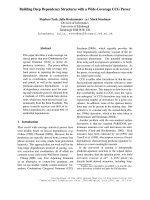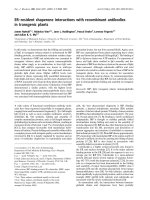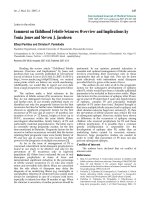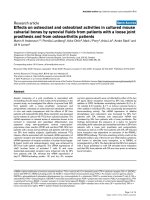Báo cáo y học: "Building on basic metagenomics with complementary technologies" ppsx
Bạn đang xem bản rút gọn của tài liệu. Xem và tải ngay bản đầy đủ của tài liệu tại đây (148.58 KB, 5 trang )
Genome Biology 2007, 8:231
Review
Building on basic metagenomics with complementary technologies
Falk Warnecke and Philip Hugenholtz
Address: Microbial Ecology Program, DOE Joint Genome Institute, Walnut Creek, CA 94598, USA.
Correspondence: Philip Hugenholtz. Email:
Abstract
Metagenomics, the application of random shotgun sequencing to environmental samples, is a
powerful approach for characterizing microbial communities. However, this method only
represents the cornerstone of what can be achieved using a range of complementary
technologies such as transcriptomics, proteomics, cell sorting and microfluidics. Together,
these approaches hold great promise for the study of microbial ecology and evolution.
Published: 28 December 2007
Genome Biology 2007, 8:231 (doi:10.1186/gb-2007-8-12-231)
The electronic version of this article is the complete one and can be
found online at />© 2007 BioMed Central Ltd
The majority of microorganisms defy axenic culture in the
laboratory and so have eluded study by the classic micro-
biological approaches [1]. With the advent of cultivation-
independent molecular tools, the true extent of microbial
diversity has been, and continues to be, revealed [2-4]. Much
of that work, however, is based on a single phylogenetic
marker gene, small subunit ribosomal RNA (ssu rRNA) [5].
By contrast, metagenomics in principle makes accessible the
entire genetic complement of a microbial community - we
define metagenomics here as the large-scale application of
random shotgun sequencing to DNA extracted directly from
environmental samples and resulting in at least 50
megabase pairs (Mbp) of sequence data. It has been barely
three years since the publication of the first large-scale
metagenomic studies: of an acid mine drainage biofilm [6]
and of ocean surface water [7]. Since then, numerous other
habitats have been investigated using this ‘basic’ meta-
genomic approach (Figure 1, arrow 1), including farmland
soil and whale falls (whale carcasses that have fallen to the
sea floor) [8], symbionts in a gutless marine worm [9],
phosphorus-removing activated sludge [10], the human [11]
and termite [12] gut and marine microbial [13,14] and viral
[15] samples. In all these cases, metagenomics provided
insights into the microbial community under study that
probably would have taken much longer to come to light
using more directed (nonrandom) approaches. Shotgun
sequencing of environmental samples has, however, a
number of limitations [16], which can best be addressed by
the use of complementary techniques.
Limitations of environmental shotgun sequencing
Three notable limitations of the basic metagenomic approach
are low resolution, the inability to classify short metagenomic
fragments, and the lack of functional verification. Perhaps
surprisingly, the resolution of microbial communities by
shotgun sequencing is rather low, with only dominant popu-
lations producing sufficient sequence coverage to result in a
sequence assembly. For example, assuming no other biases, a
population representing 0.1% of a community would account
for only 100 kilobase pairs (kbp) of a 100 Mbp metagenome,
resulting in very little coverage (0.025X coverage for a 4 Mbp
genome). If a recent study on the microbial diversity in the
deep sea is an accurate indication of species-abundance
distribution [4], rare community members comprising the bulk
of the diversity in many environmental samples will be
completely missed by current levels of shotgun sequencing.
The second limitation is in identifying the source species of
metagenomic fragments. Current methods to classify such
fragments do not perform well on sequences of less than
8 kbp [17], that is, the bulk of the sequence data obtained in
most metagenomic studies. And third, as with all DNA
sequence data, metagenomics can only provide information
on metabolic potential, and only for genes with
recognizable homology with biochemically characterized
proteins.
Divide and conquer
The first two limitations can be addressed by dividing micro-
bial communities into simpler subsets, which facilitates
contig identification and greater genomic coverage of
populations. Ironically, cultivation of pure strains is an
excellent example of this divide-and-conquer approach, as
single cells or microcolonies are separated from an environ-
mental inoculum and grown clonally on artificial media.
However, directed cultivation of organisms of environmental
relevance is typically difficult to achieve [1,18,19], although
metagenomic studies can provide valuable guidance for such
efforts [20].
Cultivation-independent methods to subdivide microbial
communities into enriched populations (see Figure 1, arrow
a) often rely on the physical properties of the target cells. For
example, populations comprising cells of atypical size can be
effectively enriched via filtration. This approach was
successfully applied to enrich phylogenetically novel popula-
tions of ultra-small archaea using filters with a 0.45 µm pore
size [21,22]. Both enriched populations have been the
subject of subsequent genome sequencing projects ([23] and
B.J. Baker, E.E. Allen and J.F. Banfield, unpublished work;
see [24]). In a metagenomic project studying bacterial endo-
symbionts of a gutless marine oligochete worm, a Nycodenz
density-gradient centrifugation was used to separate the
bacterial and eukaryotic host-cell populations, improving
the recovery of the bacterial genome sequences in subse-
quent shotgun sequencing [9].
More sophisticated techniques for separating cells from
communities are also being applied, including fluorescence-
activated cell sorting (FACS [25]) and microfluidics [26]
(see Figure 1). FACS can be used to rapidly sort large
numbers of cells belonging to specific populations on the
basis of cell properties such as size, DNA content,
photosynthetic pigments or fluorescently labeled probes
targeting the cells [27-29]. Such sorting can provide enough
biomass to allow direct extraction of DNA or RNA for the
polymerase chain reaction (PCR) and shotgun sequencing.
FACS and microfluidics can also be used to separate
individual cells, with the caveat that single cells require
whole-genome amplification, for example by multiple
Genome Biology 2007, Volume 8, Issue 12, Article 231 Warnecke and Hugenholtz 231.2
Genome Biology 2007, 8:231
Figure 1
Enhancing the basic metagenomic approach through complementary technologies. The metagenomic analysis of microbial communities by random
shotgun sequencing (arrow 1) is being enriched in one dimension by parallel detection and analysis of transcripts (‘metatranscriptomics’, arrow 2) and of
expressed proteins (‘metaproteomics’, arrow 3). In addition, because of the complexity of most natural microbial communities a separation of the
community into populations enriched in a particular group of microorganisms and even into individual cells would be advantageous. Whole-genome
amplification (WGA) is beginning to be validated as an approach to metagenomic and metatranscriptomic analysis in such samples, but there are still
some methodological constraints to be overcome (see text). The horizontal arrows indicate examples of techniques that can be used to move to the
next level of analysis, for example, (a) flow sorting and filtration and (b) microfluidics and flow sorting. SIP, stable isotope probing.
(a)
Cells
DNA
Metagenomics
RNA
Metatranscriptomics
Proteins
Metaproteomics
Microbial
community
Enriched
population
Single
cell
Basic metagenomic
approach
AUG
AUG
AUG
AUG
AUG
AUG
1
2
3
1
2
3
1
2
3
AUG
AUG
AUG
AUG
AUG
AUG
AUG
AUG
AUG
AUG
AUG
AUG
AUG
AUG
Unexplored territory
WGA
WGA
SIP
(b)
SIP
strand displacement amplification (MDA [30]), to provide
enough genomic DNA for shotgun sequencing.
Co-localization of PCR-amplified marker genes (such as
ssu rRNA) and functional genes in single cells has recently
been demonstrated in two independent studies. Ottesen and
colleagues [31] used highly parallelized microfluidic chambers
to separate individual cells and, via PCR, were able to link a
key metabolic gene in homoacetogenesis to the ssu rRNA of
treponeme spirochetes present in the termite hindgut.
Bacterial homoacetogenesis delivers the major carbon and
energy source (acetate) for the host termite, and hence
represents an important link in this mutualistic symbiosis.
Stepanauskas and Sieracki [32] flow sorted single marine
planktonic cells into microtiter plates and identified a range
of bacteria containing proteorhodopsin and other genes after
MDA and PCR. In fact, their results hint at flavobacteria as
major carriers of the proteorhodopsin gene. Compared with
large-scale shotgun sequencing, this approach represents a
rather low-cost alternative for studying the metabolic
potential of uncultivated microbes. In summary, both the
studies mentioned above mark an important milestone in
microbial ecology - the systematic linkage of identity with
function in uncultivated microorganisms. PCR-based co-
localization of genes is, however, limited by existing
sequence data and cannot access novel gene families
discovered by random shotgun sequencing.
The holy grail of de novo sequencing of sorted cells, and
individually sorted cells in particular, is to obtain a finished
genome and thus a complete inventory of an organism’s
genetic potential. The feasibility of genome sequencing from
just one or a few cells has been validated by using MDA and
partial sequencing of species with known genome sequence
(Escherichia coli [33] and Prochlorococcus [34]). This
approach has been applied to members of the candidate
bacterial phylum TM7 from the human mouth [35] and from
soil [36], yielding some insights into the metabolic potential
of novel uncultivated organisms. For example, the presence
of genes for type IV pilus biosynthesis in the isolates from
both studies [35,36] study may hint at a gliding motility
known from some Gram-positive bacteria. However, the
majority of genes of the TM7 genomes studied bear little
similarity to genes of characterized proteins.
Full genome sequencing from a single microbial cell (Figure 1,
arrow 1) remains problematic, however, due to contamina-
tion, uneven genome coverage and chimeric sequence
formation during MDA [34,37]. A number of solutions have
been proposed to somewhat mitigate these limitations.
Reducing the reaction volume increases the specific
template concentration, leading to fewer chimeric sequences
[37]. Microfluidic devices allow MDA reactions at the
nanoliter scale, which increases the specific template
concentration by three orders of magnitude [35]. Uneven
genome coverage, on the other hand, seems random [33]
and hence pooling of separate MDA reactions from
individual but genomically identical cells [36] should
improve coverage.
Going beyond metabolic potential
A major criticism of metagenomics is that it is, to some
extent, crystal-ball gazing as one attempts to infer the meta-
bolism of organisms from their DNA sequence alone (the
third limitation raised earlier: lack of functional verifica-
tion). Indeed, purely metagenomic studies often raise more
questions than they can answer. Transcriptomic and
proteomic analyses have been applied for several years to
microbial isolates in order to observe their expressed
metabolic potential [38,39]. These approaches have recently
been applied in a high-throughput fashion to microbial
communities - coining the terms ‘metatranscriptomics’ and
‘metaproteomics’.
A technical difficulty associated with transcriptomics in
bacteria and archaea is separating mRNAs from the
dominant rRNAs. The poly(A) tail of eukaryotic mRNAs
(which facilitates their separation from rRNAs before cDNA
synthesis) is not present on bacterial and archaeal
transcripts [40]. Leininger and colleagues [41] circumvented
this problem to some extent by simply using the brute force
of the new massively parallel short-read sequencing
technologies to absorb the loss of transcript sequence output
due to the predominance of rRNA. Through this approach
they provided unexpected evidence for members of the
Crenarchaeota being the most active ammonia-oxidizing
microorganisms in soil ecosystems [41].
Modern proteomic methods based on mass spectrometry
allow a fine-scale analysis of the expressed proteins of
microbial communities [42]. By combining such
techniques with genomic data, Lo et al. [43] were able to
distinguish strain-specific protein variants differing in only
a single amino-acid residue from a different site in the
same mine. Interestingly, 48% of the proteins predicted in
the genome sequence of the most abundant member in this
system, Leptospirillum group II, were detected by
proteomics. This value is higher than those reported for
many proteomic analyses of isolates and may point to a
heterogeneity of metabolic states in naturally occurring
populations [42].
Unexplored territory
By describing techniques that extend the basic metagenomic
approach in two dimensions - gene expression and trans-
lation (Figure 1, arrows 2,3) and community fractionation
(Figure 1, arrows a,b) - additional combinations become
apparent that remain to be explored (see Figure 1
‘Unexplored teritory’). Applying transcriptomics and
proteomics to separated populations will allow functional
Genome Biology 2007, Volume 8, Issue 12, Article 231 Warnecke and Hugenholtz 231.3
Genome Biology 2007, 8:231
characterization of species that have been inaccessible via
cultivation so far. The many phyla in the tree of life without
genome-sequenced representatives will provide attractive
targets for this type of analysis [2].
The application of transcriptomics and proteomics to
enriched populations or even individual microbial cells
taken directly from the environment remains technically
challenging (see Figure 1, arrows 2,3). However, the
technical hurdles may not be insurmountable. For instance,
electrospray ionization/mass spectrometry can provide
greater sensitivity than the currently standard liquid
chromatography mass spectrometry used in proteomics,
leading to smaller sample size requirements [44]. Commer-
cial kits are already available for amplifying RNAs from as
few as 50 cells (for example, QuantiTect™ from Qiagen)
paving the way for single-cell transcriptomics. Such methods
would allow functional characterization of single cells,
providing insights into the heterogeneity of expression
postulated to exist in microbial cell populations [45].
Moreover, if these approaches prove viable, such population
expression heterogeneity would be assessable in the context
of the community from which the population was derived.
Although there is still great scope for application of the basic
metagenomic approach to microbial communities - in making
spatial series [14] and in population genomics [46,47] for
example - researchers are making concerted efforts to extend
and enhance metagenomics using techniques such as flow
sorting, microfluidics, transcriptomics and proteomics. There
are many other recently developed methods that can similarly
be applied to build on or complement the basic metagenomic
approach, including stable isotope probing [48], stable isotope
mass spectroscopy [49] and subcellular high-resolution
imaging [50], guaranteeing a rich and interesting future for
those who study microbial ecology and evolution.
References
1. Kaeberlein T, Lewis K, Epstein SS: Isolating “uncultivable”
microorganisms in pure culture in a simulated natural envi-
ronment. Science 2002, 296:1127-1129.
2. Hugenholtz P: Exploring prokaryotic diversity in the genomic
era. Genome Biol 2002, 3:reviews0003.1-0003.8.
3. Rappe MS, Giovannoni SJ: The uncultured microbial majority.
Annu Rev Microbiol 2003, 57:369-394.
4. Sogin ML, Morrison HG, Huber JA, Welch DM, Huse SM, Neal PR,
Arrieta JM, Herndl GJ: Microbial diversity in the deep sea and
the underexplored “rare biosphere”. Proc Natl Acad Sci USA
2006, 103:12115-12120.
5. Pace NR: A molecular view of microbial diversity and the
biosphere. Science 1997, 276:734-740.
6. Tyson GW, Chapman J, Hugenholtz P, Allen EE, Ram RJ, Richardson
PM, Solovyev VV, Rubin EM, Rokhsar DS, Banfield JF: Community
structure and metabolism through reconstruction of micro-
bial genomes from the environment. Nature 2004, 428:37-43.
7. Venter JC, Remington K, Heidelberg JF, Halpern AL, Rusch D, Eisen
JA, Wu DY, Paulsen I, Nelson KE, Nelson W, et al.: Environmental
genome shotgun sequencing of the Sargasso Sea. Science
2004, 304:66-74.
8. Tringe SG, von Mering C, Kobayashi A, Salamov AA, Chen K, Chang
HW, Podar M, Short JM, Mathur EJ, Detter JC, et al.: Comparative
metagenomics of microbial communities. Science 2005, 308:
554-557.
9. Woyke T, Teeling H, Ivanova NN, Huntemann M, Richter M,
Gloeckner FO, Boffelli D, Anderson IJ, Barry KW, Shapiro HJ, et al.:
Symbiosis insights through metagenomic analysis of a
microbial consortium. Nature 2006, 443:950.
10. Garcia Martin H, Ivanova N, Kunin V, Warnecke F, Barry KW,
McHardy AC, Yeates C, He S, Salamov AA, Szeto E, et al.: Meta-
genomic analysis of two enhanced biological phosphorus
removal (EBPR) sludge communities. Nat Biotechnol 2006, 24:
1263.
11. Gill SR, Pop M, DeBoy RT, Eckburg PB, Turnbaugh PJ, Samuel BS,
Gordon JI, Relman DA, Fraser-Liggett CM, Nelson KE: Meta-
genomic analysis of the human distal gut microbiome.
Science 2006, 312:1355-1359.
12. Warnecke F, Luginbühl P, Ivanova N, Ghassemian M, Richardson TH,
Stege JT, Djordjevic G, Aboushadi N, Sorek R, Tringe SG, et al.:
Functional metagenomics implicates termite hindgut bacte-
ria as major catalysts in wood hydrolysis. Nature 2007, 450:
560-565.
13. DeLong EF, Preston CM, Mincer T, Rich V, Hallam SJ, Frigaard N-U,
Martinez A, Sullivan MB, Edwards R, Brito BR,
et al.: Community
genomics among stratified microbial assemblages in the
ocean’s interior. Science 2006, 311:496-503.
14. Rusch DB, Halpern AL, Sutton G, Heidelberg KB, Williamson S,
Yooseph S, Wu D, Eisen JA, Hoffman JM, Remington K, et al.: The
Sorcerer II Global Ocean Sampling expedition: northwest
Atlantic through eastern tropical Pacific. PLoS Biol 2007, 5:e77.
15. Angly FE, Felts B, Breitbart M, Salamon P, Edwards RA, Carlson C,
Chan AM, Haynes M, Kelley S, Liu H, et al.: The marine viromes
of four oceanic regions. PLoS Biol 2006, 4:e368.
16. Tyson GW, Hugenholtz P: Environmental shotgun sequencing.
In Encyclopedia of Genetics, Genomics, Proteomics and Bioinformatics.
New York: John Wiley & Sons; 2005.
17. Mavromatis K, Ivanova N, Barry K, Shapiro H, Goltsman E, McHardy
AC, Rigoutsos I, Salamov A, Korzeniewski F, Land M, et al.: Use of
simulated data sets to evaluate the fidelity of metagenomic
processing methods. Nat Methods 2007, 4:495.
18. Hahn MW: Isolation of strains belonging to the cosmopolitan
Polynucleobacter necessarius cluster from freshwater habi-
tats located in three climatic zones. Appl Environ Microbiol 2003,
69:5248-5254.
19. Rappe MS, Connon SA, Vergin KL, Giovannoni SJ: Cultivation of
the ubiquitous SAR11 marine bacterioplankton clade. Nature
2002, 418:630-633.
20. Tyson GW, Lo I, Baker BJ, Allen EE, Hugenholtz P, Banfield JF:
Genome-directed isolation of the key nitrogen fixer Lep-
tospirillum ferrodiazotrophum sp. nov. from an acidophilic
microbial community. Appl Environ Microbiol 2005, 71:6319-6324.
21. Baker BJ, Tyson GW, Webb RI, Flanagan J, Hugenholtz P, Allen EE,
Banfield JF: Lineages of acidophilic archaea revealed by com-
munity genomic analysis. Science 2006, 314:1933-1935.
22. Huber H, Hohn MJ, Rachel R, Fuchs T, Wimmer VC, Stetter KO: A
new phylum of Archaea represented by a nanosized hyper-
thermophilic symbiont. Nature 2002, 417:63-67.
23. Waters E, Hohn MJ, Ahel I, Graham DE, Adams MD, Barnstead M,
Beeson KY, Bibbs L, Bolanos R, Keller M, et al.: The genome of
Nanoarchaeum equitans: insights into early archaeal evolu-
tion and derived parasitism. Proc Natl Acad Sci USA 2003,
100:12984-12988.
24. Joint Genome Institute: why sequence Euryarchaeota
in acid
mine drainage? [ />Euryarchaeota.html]
25. Brehm-Stecher BF, Johnson EA: Single-cell microbiology: tools,
technologies, and applications. Microbiol Mol Biol Rev 2004, 68:
538-559.
26. Weibel DB, DiLuzio WR, Whitesides GM: Microfabrication
meets microbiology. Nat Rev Microbiol 2007, 5:209-218.
27. Fuchs BM, Zubkov MV, Sahm K, Burkill PH, Amann R: Changes in
community composition during dilution cultures of marine
bacterioplankton as assessed by flow cytometric and molec-
ular biological techniques. Environ Microbiol 2000, 2:191-202.
28. Robertson BR, Button DK, Koch AL: Determination of the bio-
masses of small bacteria at low concentrations in a mixture
of species with forward light scatter measurements by flow
cytometry. Appl Environ Microbiol 1998, 64:3900-3909.
Genome Biology 2007, Volume 8, Issue 12, Article 231 Warnecke and Hugenholtz 231.4
Genome Biology 2007, 8:231
29. Sekar R, Fuchs BM, Amann R, Pernthaler J: Flow sorting of marine
bacterioplankton after fluorescence in situ hybridization.
Appl Environ Microbiol 2004, 70:6210-6219.
30. Hosono S, Faruqi AF, Dean FB, Du Y, Sun Z, Wu X, Du J, Kingsmore
SF, Egholm M, Lasken RS: Unbiased whole-genome amplification
directly from clinical samples. Genome Res 2003, 13:954-964.
31. Ottesen EA, Hong JW, Quake SR, Leadbetter JR: Microfluidic
digital PCR enables multigene analysis of individual environ-
mental bacteria. Science 2006, 314:1464-1467.
32. Stepanauskas R, Sieracki ME: Matching phylogeny and metabo-
lism in the uncultured marine bacteria, one cell at a time.
Proc Natl Acad Sci USA 2007, 104:9052-9057.
33. Abulencia CB, Wyborski DL, Garcia JA, Podar M, Chen W, Chang
SH, Chang HW, Watson D, Brodie EL, Hazen TC, et al.: Environ-
mental whole-genome amplification to access microbial
populations in contaminated sediments. Appl Environ Microbiol
2006, 72:3291-3301.
34. Zhang K, Martiny AC, Reppas NB, Barry KW, Malek J, Chisholm SW,
Church GM: Sequencing genomes from single cells by poly-
merase cloning. Nat Biotechnol 2006, 24:680-686.
35. Marcy Y, Ouverney C, Bik EM, Losekann T, Ivanova N, Martin HG,
Szeto E, Platt D, Hugenholtz P, Relman DA, et al.: Dissecting bio-
logical “dark matter” with single-cell genetic analysis of
rare and uncultivated TM7 microbes from the human
mouth. Proc Natl Acad Sci USA 2007, 104:11889-11894.
36. Podar M, Abulencia CB, Walcher M, Hutchison D, Zengler K, Garcia
JA, Holland T, Cotton D, Hauser L, Keller M: Targeted access to
the genomes of low-abundance organisms in complex
microbial communities. Appl Environ Microbiol 2007, 73:3205-
3214.
37. Hutchison CA, III, Smith HO, Pfannkoch C, Venter JC: Cell-free
cloning using
φφ
29 DNA polymerase. Proc Natl Acad Sci USA
2005, 102:17332-17336.
38. Völker U, Hecker M. From genomics via proteomics to cellu-
lar physiology of the Gram-positive model organism Bacillus
subtilis. Cell Microbiol 2005, 7:1077-1085.
39. Thompson A, Rowley G, Alston M, Danino V, Hinton JC. Salmo-
nella transcriptomics: relating regulons, stimulons and regu-
latory networks to the process of infection. Curr Opin Microbiol
2006, 9:109-116.
40. Poretsky RS, Bano N, Buchan A, LeCleir G, Kleikemper J, Pickering
M, Pate WM, Moran MA, Hollibaugh JT: Analysis of microbial
gene transcripts in environmental samples. Appl Environ Micro-
biol 2005, 71:4121-4126.
41. Leininger S, Urich T, Schloter M, Schwark L, Qi J, Nicol GW, Prosser
JI, Schuster SC, Schleper C: Archaea predominate among
ammonia-oxidizing prokaryotes in soils. Nature 2006, 442:806.
42. Ram RJ, VerBerkmoes NC, Thelen MP, Tyson GW, Baker BJ, Blake
RC, II, Shah M, Hettich RL, Banfield JF: Community proteomics
of a natural microbial biofilm. Science 2005, 308:1915-1920.
43. Lo I, Denef VJ, VerBerkmoes NC, Shah MB, Goltsman D, DiBartolo
G, Tyson GW, Allen EE, Ram RJ, Detter JC, et al.: Strain-resolved
community proteomics reveals recombining genomes of
acidophilic bacteria. Nature 2007, 446:537-541.
44. Ibrahim Y, Tang KQ, Tolmachev AV, Shvartsburg AA, Smith RD:
Improving mass spectrometer sensitivity using a high-
pressure electrodynamic ion funnel interface. J Am Soc Mass
Spectrom 2006, 17:1299-1305.
45. Newman JR, Ghaemmaghami S, Ihmels J, Breslow DK, Noble M,
DeRisi JL, Weissman JS: Single-cell proteomic analysis of S. cere-
visiae reveals the architecture of biological noise. Nature 2006,
441:840-846.
46. Johnson PLF, Slatkin M: Inference of population genetic para-
meters in metagenomics: a clean look at messy data. Genome
Res 2006, 16:1320-1327.
47. Whitaker RJ, Banfield JF: Population genomics in natural micro-
bial communities. Trends Ecol Evol 2006, 21:508-516.
48. Dumont MG, Murrell JC: Stable isotope probing - linking
microbial identity to function. Nat Rev Microbiol 2005, 3:499-
504.
49. Lechene C, Hillion F, McMahon G, Benson D, Kleinfeld AM, Kampf
JP, Distel DL, Luyten Y, Bonventre J, Hentschel D, et al.: High-reso-
lution quantitative imaging of mammalian and bacterial
cells using stable isotope mass spectrometry. J Biol 2006, 5:20.
50. McDonald KL, Auer M: High-pressure freezing, cellular tomog-
raphy, and structural cell biology. Biotechniques 2006, 41:
137,139,141 passim.
Genome Biology 2007, Volume 8, Issue 12, Article 231 Warnecke and Hugenholtz 231.5
Genome Biology 2007, 8:231









